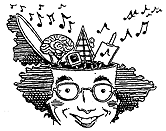Dedication
Introduction
Dan Ariely
Walter Bender
Steve Benton
Bruce Blumberg
V. Michael Bove, Jr.
Cynthia Breazeal
Ike Chuang
Chris Csikszentmihályi
Glorianna Davenport
Judith Donath
Neil Gershenfeld
Hiroshi Ishii
Joe Jacobson
Andy Lippman
Tod Machover
John Maeda
Scott Manalis
Marvin Minsky
William J. Mitchell
Seymour Papert
Joe Paradiso
Sandy Pentland
Rosalind Picard
Mitchel Resnick
Deb Roy
Chris Schmandt
Ted Selker
Barry Vercoe
Tod Machover
My passion is people, and music has long been my preferred medium for thinking about people and about life: I think to compose; I think through composing.
On the surface, we seem to be in the midst of a musical renaissance: music surrounds us everywhere, heard in elevators, sports arenas, cars and kitchens, downloaded and remixed at will, an accompaniment to our everyday lives. This is not surprising, as music arguably combines more mental abilities—primitive and refined emotional reaction, rhythmic body response, sensitivity to time passing and remembered, analytical deductions and comparisons, narrative perception, psychological resonance—than any other human activity. (It has been said that music provides the closest "map of our minds.") But beneath the surface, the picture is not so bright. Much of this sonic surfeit is mere wallpaper, a comforting background that dulls—rather than intensifies—our imagination and curiosity. Seemingly the more music there is, the more we devalue it and the less attention we pay, the less open we are to being touched and transformed.

We must reinvigorate and reinvent music so that it reaches its full potential and power. Technology is key, providing skill augmenters for performance; allowing active manipulation and exploration of musical materials; opening doors to composing and improvising; immersing the listener within a sonic structure; and facilitating expressive communication and collaboration. Such new tools can be adapted to any level of skill or experience, enhancing expressive power for virtuosi while permitting amateurs of all ages to learn and create. For the past fifteen years, we have developed instruments, environments, and compositions in all of these areas, from the Philip K.Dick-based "Valis" opera, to a Hypercello for Yo-Yo Ma, to a Sensor Chair for Penn & Teller, to the audience-interactive "Brain Opera," to our recent "Toy Symphony," which brings together young and old, experienced and novice, and enables anyone to design their own music using Hyperscore.
It is time to establish a musical language for the future: one that zooms between atoms and galaxies of sound; that finds beauty in natural and artificial hybrids, stretching past the "electric" to the physical and the ephemeral; which speaks with immediate impact while promising layers of secrets; and which touches on every known thought and feeling while leading to unimagined horizons. And using technology as mediator, we must finally create the gesamtkunstwerk that Wagner imagined well over 100 years ago—merging performance, design, and architecture to establish a synergy of the senses, extending from the tiniest gesture to the scope of grand cities. These converged human arts will provide the platform for future expression, but also for exploration, understanding, and growth. Such research will lead to new kinds of institutions, "centers for arts and invention," where professionals, students, children, and the general public will pursue personal and collective enrichment, and where the stage will be set to unite people of every background, experience, and need, across generations and around the world.
Favorite childhood toy: dressing up as historical figures; Teddy Roosevelt was my specialty